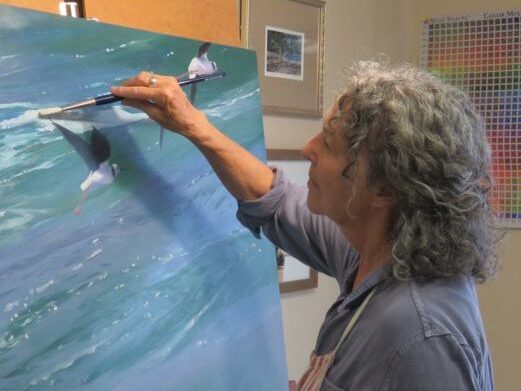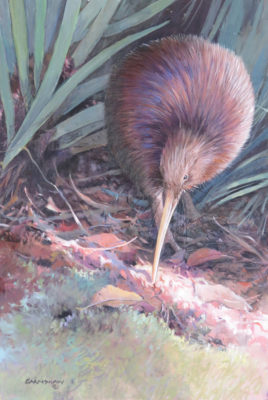Adele Earnshaw grew up in rural Warkworth on a 7-acre property that edged a river, a tributary of the Mahurangi River and with a huge area of native bush nearby. Kiwi have always been special to her.
“During my childhood I was always looking for kiwi,” Adele remembers, “But Dad used to say, ‘no Dell, they’re all gone’.”
Nowadays she lives in Opua.
“The kiwi are still here and coming back with conservation,” she says. “I can hear kiwi in the Opua Forest in summer when my doors are open in the evening.”

Adele regularly checks a trapline on her own property and traps for possums, rats and mice. She is also an internationally successful artist using her art to raise funds to help kiwi. But her life journey to get to this point has taken her a whole lot further than the 2-hour road trip from Warkworth to Opua.
“My family left New Zealand when I was 12 and I lived in the United States for most of my life, but I’ve always travelled back and forth. When I was 18 I joined an airline as a flight attendant so that I could get passes to come back,” she says. “For the last 35 years I’ve been an artist fulltime and I found I was coming to New Zealand for longer and longer every year, so I thought why not live here?”
When Adele told her family back in the US that she was thinking of returning to New Zealand permanently, their reaction was telling.
“When I asked Dad how he’d feel if I moved back, he said ‘you might as well, you never really left!’ I’ve been back now for 6 years.”
Originally Adele’s parents had planned to return themselves and retire to nearby Paihia, but her mother died many years ago. Her father, now aged 96, thought of returning a couple of years ago, but has decided that he is now too old for the change.
“I still earn my living through US galleries and go back for a month or two every year,” Adele says.
Adele had previously worked on conservation programmes both for NZ and in the US, so knew that art was a good way to raise money for conservation.
“Between 1993 and 1995 I designed the stamps used in the first 3 years of the New Zealand Fish and Game Council’s Game Bird Stamp Programme. They’re hunting stamps not postage stamps,” she explains. “They’re based on the US Duck Stamp scheme. You purchase stamps for your hunting licence. They’re very collectible in the US and raise funds for US wildlife refuges. The New Zealand Game Bird Stamp programme raised over $1million for habitat in its first year.”
Back living in New Zealand, Adele joined the Bay Bush Action conservation group, helping out with volunteer work.

“But I’m better at painting then trapping,” she says, “So I presented my art print idea to the group a couple of years ago. It’s a good way for me to contribute personally.”
The project works like this: Adele sold a painting to one of her regular international collectors (a US collector based in Germany) and donated all the proceeds to Paihia Rotary who are using the money to cover printing costs etc for fine-art quality reproduction prints of the painting.
The art prints are produced for Bay Bush Action at cost, by professional photographer/printer Dean Wright of Opito Bay and are available for sale ($75 unframed, $200 framed) through the Bay Bush Action’s website. Not only has Adele donated the original painting, she also donates her time to frame, pack and ship the prints to buyers.
“I don’t make a penny from the prints myself. They’re printed at cost and when they’re sold, 100% goes to Bay Bush action,” she says.
Not surprisingly, the subject Adele chose to paint for the group’s fundraising project, was a kiwi. A one-legged kiwi called Sparky was her muse and Adele made a number of trips to Whangarei to visit Sparky and make sure she depicted kiwi details accurately.
“Sparky can never be released, but he’s a kiwi ambassador at the rehabilitation centre in Whangarei. He was a kiwi I could touch and photograph, although no actual photograph looks like the finished print,” she explains. “Dean Wright also took close-up photos of a kiwi beak, legs etc for the photographic references I needed for accuracy.”
Adele also explored the Oromahoe Traverse – a path through Opua Forest – looking at habitat and the plants found there, including an epiphyte that typically grows in the forest.
“I wanted the kiwi’s habitat to look more ‘Opua Forest’ than other parts of New Zealand,” she explains. “I also ran the painting by people who know kiwi to see if there was anything that wasn’t right. It took a long time to do this painting because I wanted to make sure it was accurate.”
The painting was done in oils, although in the early part of her career, Adele was a watercolourist.
“I switched to oil about 15 years ago,” she says. “The painting gods pushed me! I had reached a ceiling where I was typecast, doing ‘cute stuff’ and I knew I needed to change. Then I broke my wrist. With watercolours you work flat and your wrist needs to be very flexible. With oil I was able to work vertically on an easel and I found that I could stand back and paint even with a stiff splinted forearm. My wrist took a long time to heal – and by then I was an oil painter!”
Funds raised from the sale of the art prints will contribute towards Bay Bush Action’s longterm plans to increase the number of kiwi in Opua.
“The funds raised from the sale of this print will be used for an upcoming kiwi release in the Opua Forest and/or Project Nest Egg, where kiwi eggs are incubated and the chicks released in the Opua Forest when they are large enough to defend themselves,” Adele says.
With nest egg projects, kiwi burrows are monitored and the first egg removed. Eggs are incubated artificially and chicks raised on an island until they’re a year old and big enough to fight off stoats.
“I’ve been a firm believer in goal-setting since I first started painting,” says Adele. “I have short/longterm and life goals and one of my life goals was to come back to New Zealand and help kiwi.”
With Adele’s kiwi prints now available to purchase and 100% of profits going to Bay Bush Action, that goal is well on its way to being achieved.
If you’d like to find out more about purchasing a print ($75 unframed, $200 framed), check out the Bay Bush Action website for details. You can see more of Adele’s art on her personal website.

